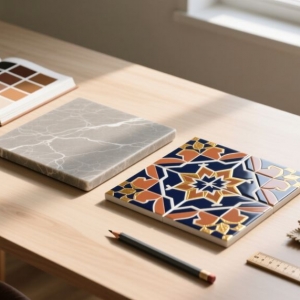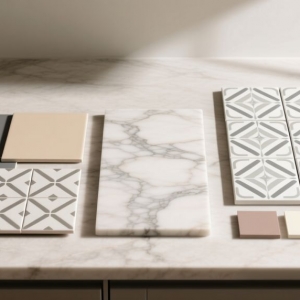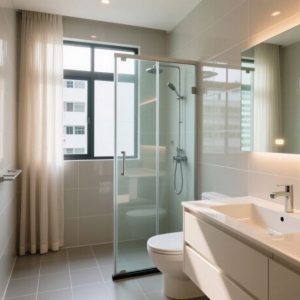Deciding between porcelain and ceramic tiles can be tricky. They often look similar, but their performance varies once installed. Choosing wisely now can save you from costly repairs later. So, what sets them apart? Where do they work best? And how do you make the right call?
What Makes Them Different?
Both porcelain and ceramic tiles are made from clay, fired in a kiln, and often glazed for a finished look. But their composition tells a different story.
Porcelain tiles are denser, fired at higher temperatures, and absorb very little water, making them tougher and more moisture-resistant. Ceramic tiles are less dense, more porous, and easier to work with during installation.
These traits determine where each tile is most effective.
Porcelain: Strong and Weather-Tough
Porcelain is a standout for spaces that face heavy use. Its dense composition makes it perfect for high-traffic areas like kitchen floors, commercial lobbies, or entryways. It resists wear, stains, and scratches with ease.
Its low water absorption makes it ideal for wet environments—shower stalls, outdoor porches, or mudrooms. Porcelain can handle moisture and temperature swings without cracking.
The trade-off? Porcelain is harder to cut and install, requiring specialized tools and often more time, which can raise costs or challenge DIYers.
Ceramic: Easy and Style-Focused
Ceramic tiles shine in less intense settings. They’re lighter, easier to cut, and typically more affordable, making them great for DIY projects or budget renovations.
Ceramic feature wall tiles, for instance, are perfect for adding flair to spaces like bathroom walls or kitchen backsplashes. These areas don’t need heavy-duty durability, and ceramic’s wide range of designs—colors, textures, and patterns—makes it a design favorite.
Ceramic’s porosity makes it less suited for wet or outdoor spaces, but it’s ideal for dry, decorative applications.
Where Each Works Best
Your decision hinges on the space and its demands. Here’s a straightforward breakdown:
Opt for porcelain when:
- Tiling wet areas (bathrooms, outdoor patios, laundry areas)
- Facing high-traffic zones (hallways, retail spaces)
- Seeking long-lasting, low-maintenance surfaces
Choose ceramic when:
- Tiling walls or low-traffic areas (accent walls, backsplashes)
- Handling DIY projects needing easy-to-cut materials
- Prioritizing design variety on a budget
A trusted tiles supplier will ask about your project’s specifics—location, usage, and installation plans—to recommend the best fit.
Water Resistance and Longevity
Porcelain’s low water absorption (under 0.5%) makes it a top pick for wet or outdoor spaces. It resists moisture-related issues like cracking or mold, even in harsh climates.
Ceramic tiles, being more absorbent, are better for dry areas like interior walls or low-traffic floors. Using them in wet zones risks damage over time.
A tiles supplier can guide you to avoid errors, like using ceramic where porcelain’s resilience is needed.
Cost and Installation
Ceramic tiles are generally cheaper to buy and install. Their softer material simplifies cutting, keeping labor costs down and suiting DIYers.
Porcelain is pricier and requires specialized tools for cutting, often increasing installation costs. But its durability can save money by reducing future repairs.
A tiles supplier can help you weigh these factors to match your budget and goals.
Design and Visual Appeal
Ceramic tiles often lead in design options, offering bold colors, intricate patterns, and textured finishes at a lower price. They’re perfect for creative projects like decorative walls or vibrant backsplashes.
Porcelain tiles have advanced, with designs mimicking natural materials like marble or oak. Still, ceramic typically offers more affordable style variety.
Making the Decision
Choose porcelain for wet, high-traffic, or outdoor areas where durability and water resistance are key. Opt for ceramic for decorative, low-traffic, or budget-driven projects where style and ease matter most.
Uncertain? A tiles supplier can clarify your options. Share your project’s specifics, and they’ll point you to the tile that fits your needs.
Closing Thought
Neither porcelain nor ceramic is “better”—it’s about what your project demands. Consider durability, moisture exposure, design, and budget. A quick conversation with a tiles supplier can ensure you pick a tile that looks fantastic and performs for years.











